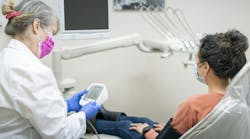What is the 'COVID-ified' future for dentists?
By Puneet Bhatnagar
In October 2015, blood samples were collected from 218 villagers in Jinning county, China. The villages surround caves that are known to host SARS-related coronavirus-carrying bats. The blood samples found that nearly 3% carried antibodies against SARS-like coronavirus. None of the people had come in contact with the bats or exhibited clinical symptoms. This was the first recorded instance of a bat-to-human transmission of the coronaviruses.
This research, published in 2018,1 also mentioned that these coronaviruses have a high rate of mutation and "are prone to recombination if different viruses infect the same individual.”2 Who would have thought that the cocktail brewing in this remote area of China would wipe an estimated $2 trillion out of the world economy in a mere two years? In his 1981 novel, The Eyes of Darkness, Dean Koontz came close to predicting all of this, but that was a pure work of fiction.
This is a "novel” coronavirus and everything about it is, well, novel. There were only six known coronaviruses before this, which is the seventh. So, there is no reference point available to understand how this virus behaves or responds. It will take years to understand the real impact of this mega pandemic. There will be books and research papers about the human cost of it all. This article is my very modest attempt to understand the current impact of the pandemic and how it will impact the future outlook for the profession of dentistry. I have used existing research, personal life experience, assumptions, and industry data to try to make some sense of all of this madness.
The current impact
COVID-19 came out of nowhere. It may be what economists call a black swan—a rare and inherently unforeseeable event with severe consequences. A pandemic often results in global and US recessions, and that is now happening during the first half of 2020. The economy was already fragile and vulnerable to anything that did not stick to the script before the outbreak. COVID-19 is way off script.5 The virus is going to impact every aspect of global business. It shut down Dow Jones, then spooked it enough that it crashed 30% from its historic high achieved last month. Almost every sector is being affected by this event (figure 1).
Before looking at the effects of COVID-19 on the dental profession, for comparison sake, I’m going to see how it’s affecting other sectors in terms of business and consumer behavior.
Aviation: Most airlines have the cash flow to sustain them only until June 2020, and the industry is looking at a $200 billion bailout to survive. Travel is not going to be a priority for most people, either now or as they try to piece together a normal life after the restrictions are lifted.
Banking: Banks are being tested to their limits with a combination of surging credit spreads, shrinking interest margins, rising loan loss reserves, and increasing default risk. Interest, banks’ major revenue stream, will be under tremendous pressure in the coming months.
Supermarkets: These stores have climbed high in terms of priority. Consumer buying behaviors will undergo a drastic change and people will likely tend toward hoarding important supplies for the future. This is similar to how people acted during and after the world wars.
The present and future of dentistry
Dental practice owners now face a challenge they have not been prepared for. No dental school or management training program could have envisioned a situation like this one, where there is a prolonged period of interruption.
Patient management: Practices are using every possible method (mailers, voice messages, social media, and practice websites) to inform patients about the office closures for everyday dentistry. Patient screening protocols, such as the one created by the American Association of Endodontists (AAE), should continue even after the restrictions are lifted (figure 2).
Patients are very understanding and are not willing to take risks themselves. Practices need to reiterate the strict CDC and OSHA guidelines that are being implemented.
Staff management: The most unfortunate impact of practices being closed is on staff salaries. Many on the staff have less wiggle room as far as finances are concerned. Unemployment insurance will only partially meet their requirements and, since most practice owners are now compromised financially due to uncertainty, the steps taken by the federal government in the next few weeks will be watched closely by everyone.
Hiring associates and hygienists: There is a lot of confusion among dental graduates regarding hiring patterns due to this crisis. The vacancies in dental practices primarily serve one of two purposes—replacing an associate who is exiting or expanding a corporate office. For the first, it is likely that dentists will wait to see how patients are responding. If they quickly recover, then there will be in an urgency to hire to catch up for lost time. It may be trickier for the corporate jobs. Practice owners and corporations will likely respond based on how their financers, such as banks, adjust to the new reality. Some may still expand their practices while others may defer the move for the future. The situation may initially be a little tougher for dental hygienists, but it will plateau soon. I believe that any such effect will last only for the current hiring cycle and may not extend beyond a few months.
Dental supply companies: Personal protective equipment (PPE) such as gloves, gowns, goggles, and face masks, as well as cleaning, diagnostic, surgical, and wound care products have been produced mainly by big suppliers in China. This dependence on China will surely decrease. This is good news for manufacturers in North America. Take the case of Prestige Ameritech, a Texas-based company that manufactures masks. They used to make 250,000 masks per day and have now ramped up production to one million masks. They actually recently turned down orders worth millions.4 This will mean the price of disposable items from Henry Schein, Patterson, and other companies may go up in the future. The supply schedule will be disrupted during the months to come and dentists will see a lot of backorders on many products.
Insurance: The insurance companies are being inundated with calls about pandemic coverage and they face a unique situation where they may have to compensate all of their policyholders. This will put them under tremendous pressure. The insurance companies will tend to resist the claims by pulling in all the legal justifications (figure 3). There is also the likelihood that dentists will respond with a combined plea to the government in the near future.
Banks: It is reasonable to expect banks to give a pass for a few months, at least regarding paying practice loan premiums. Reports suggest that banks are already in talks with the federal government about this. This may not help dental students and new grads since their education loans and lines of credit are completely different ballgames.
Future outlook
It is very difficult to predict what the future holds for dentistry. There are lessons to be learned from the deadliest pandemic ever to hit the human race—the 1918 Spanish flu. The situation was worse than this one because the world faced a double whammy in that the flu outbreak was at the same time as World War I. A study conducted on the business impact of the flu showed that the pandemic led to a significant increase in poverty rates.6 There is also evidence that capital returns were negatively affected by the pandemic. However, contrary to predictions, there was no discernible effect on earnings. Imagine recovering from two calamities, yet incomes and earnings did not go down (figure 4)!
Let's consider the month the federal government removes travel and group gathering restrictions as month zero. Expect consumer spending to return within a week of month zero. It is expected that consumers will spend on essentials followed by a period of liquidity crunch where spending will decrease again. This is expected to be followed by a sustained period of high growth in consumer confidence.
For dentistry, this may mean that patients initially focus only on emergency procedures or the treatment that really matters to them. This might not be very good news for hygienists and orthodontics. But there is an alternate possibility where patients, fresh from “house arrest,” go all out and spend money on things that make them look good and feel better. These completely different consumer reactions were recorded after life-changing incidents such as 9/11.
So, in a nutshell, there is no point in being pessimistic about the future of the dental profession.
Conclusion
In all probabilities, the virus will stay with us. There will be changes in behavior such as less travel, reduced smoking, increased use of pneumococcal vaccines, higher online sales and food ordering, higher interest in online courses, social distancing, more movies about viral outbreaks—the list is endless.
The rampant exploitation of natural resources has brought us face-to-face with animals that harbor these novel viruses. Eminent public health researcher Peter Daszak and his team have estimated that there are as many as 5,000 coronavirus strains globally waiting to be discovered in bats. We are possibly looking at a future where pandemics and epidemics become a part of life and health takes the center stage in public policy and even election campaigning, as seen in the upcoming election. As dentists, and more importantly, as health professionals we have to play our part in preparing people for this new reality.
I ask readers to remember that what I’ve discussed in this article is mostly conjecture-based, and I hope, like all of you, that the future is filled with promise and hope!
Puneet Bhatnagar is a 2020 DDS candidate in clinical dentistry at the University of Western Ontario.
References
1. Ning Wang, Shi-Yue Li, Xing-Lou Yang, et al. Serological Evidence of Bat SARS-Related Coronavirus Infection in Humans, China. 2018:Feb;33(1)104–107.
2. Knipe DM, Howley PM, Cohen JI, Griffin DE, Lamb RA, Martin MA, Racaniello VR, Roizman B. Fields virology. Alphen aan den Rijn: Wolters Kluwer/Lippincott Williams and Wilkins;2013.
3. Coronavirus: Can policymakers avert a trillion-dollar crisis. UNCTAD. https://unctad.org/en/pages/newsdetails.aspx?OriginalVersionID=2300.
4. The ‘Surreal’ Frenzy Inside the US’ Biggest Mask Maker. Wired.com. https://www.wired.com/story/surreal-frenzy-inside-us-biggest-mask-maker/
5. Assessing the Economic Impact of the COVID-19 Virus Under Alternative Scenarios. Moody analytics
6. Karlssona M, Nilssonc T, Pichler S. The impact of the 1918 Spanish flu epidemic on economic performance in Sweden An investigation into the consequences of an extraordinary mortality shock/ Jour Health Econ. 36 (2014) 1–19
Editor's note: For more articles about coronavirus and dentistry, visit the COVID-19 Resource Center on DentistryIQ.







